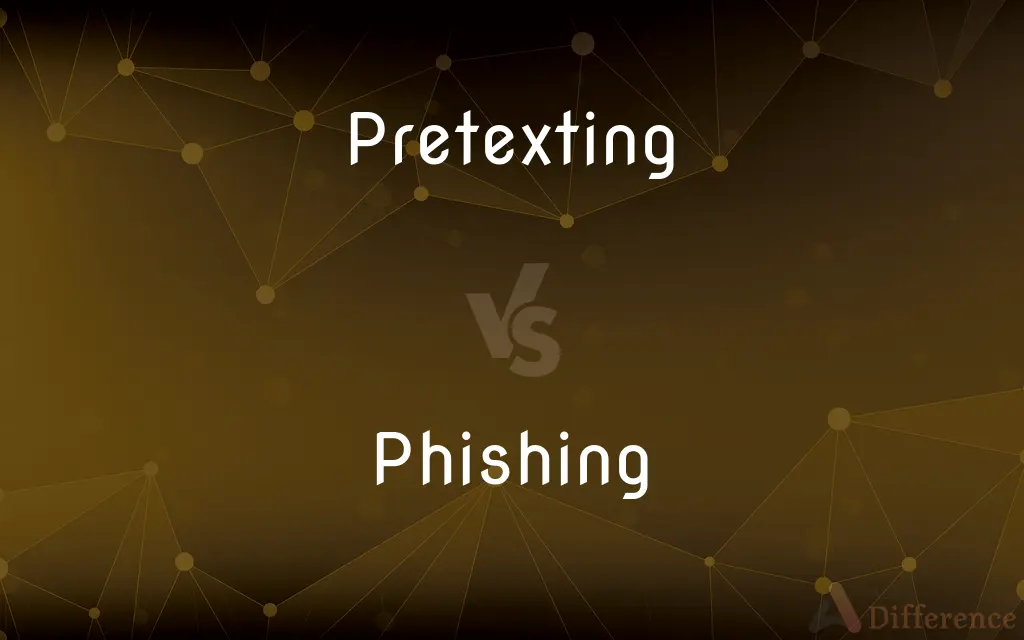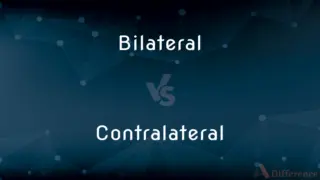Pretexting vs. Phishing — What's the Difference?
By Maham Liaqat & Urooj Arif — Updated on March 29, 2024
Pretexting involves creating a fabricated scenario to obtain personal information, while phishing uses deceptive communications to trick individuals into revealing it.

Difference Between Pretexting and Phishing
Table of Contents
ADVERTISEMENT
Key Differences
Pretexting is a social engineering technique where attackers create a false narrative to gain the trust of their victims and obtain personal information. This method relies on building a believable story that necessitates the disclosure of information. For example, a pretexter might impersonate a co-worker or an authority figure to justify their inquiries, focusing on manipulating human psychology. Phishing, on the other hand, typically involves sending fraudulent communications that appear to come from reputable sources, such as emails or text messages, to trick individuals into revealing personal information, such as passwords and credit card numbers. Unlike pretexting, phishing often targets large groups of people, hoping that some will not recognize the deceit and comply with the requests.
While pretexting often requires more detailed knowledge about the victim to construct a believable story, phishing attacks can be more generic, designed to exploit common vulnerabilities among a wider audience. Pretexting attacks are usually more targeted, focusing on specific individuals or companies, and require a higher level of customization.
The success of pretexting relies heavily on the attacker's ability to appear convincing and authoritative, demanding creativity and improvisation skills. In contrast, phishing exploits fear, urgency, or curiosity, using alarming or enticing messages to prompt quick action from victims.
Both techniques demonstrate the importance of being cautious with personal information and verifying the identity of anyone who requests sensitive details. However, the preventive measures for each can differ, emphasizing education and awareness for phishing and critical thinking and verification for pretexting.
Comparison Chart
Definition
Fabricating a scenario to obtain information.
Sending deceptive communications to get information.
ADVERTISEMENT
Primary Technique
Constructing a believable story.
Sending fraudulent messages.
Target
Often specific individuals or organizations.
Usually a broad audience.
Reliance
On the attacker's ability to manipulate and improvise.
On exploiting fear, urgency, or curiosity.
Prevention
Critical thinking and verification of identities.
Education on recognizing fraudulent communications.
Compare with Definitions
Pretexting
Fabricating a scenario to gather personal data.
Pretending to need information for a security audit to access employee records.
Phishing
Sending emails posing as a reputable entity to steal information.
Sending an email that mimics a bank's communication style to get account details.
Pretexting
Impersonating someone in authority to gain trust.
Posing as a bank official to verify account details.
Phishing
Leveraging popular events or news for scams.
Sending donation requests from a fake charity after a natural disaster.
Pretexting
Utilizing social engineering to manipulate individuals.
Convincing someone they are part of an internal investigation to obtain login credentials.
Phishing
Using malicious links or attachments in messages.
Encouraging the recipient to click on a link that installs malware.
Pretexting
Creating a detailed background story to justify information requests.
Claiming to be part of a research team needing access to personal data.
Phishing
Exploiting urgency or fear to provoke immediate action.
Claiming an account will be closed if immediate verification is not provided.
Pretexting
Relying on human psychology and trust.
Building rapport with a target to extract sensitive information.
Phishing
Targeting a wide audience with generic messages.
Mass-emailing a password reset scam to many users, hoping some will comply.
Pretexting
Pretexting is a type of social engineering attack that involves a situation, or pretext, created by an attacker in order to lure a victim into a vulnerable situation and to trick them into giving private information, specifically information that the victim would typically not give outside the context of the pretext. In its history, pretexting has been described as the first stage of social engineering, and has been used by the FBI to aid in investigations.
Phishing
Phishing is a type of social engineering where an attacker sends a fraudulent ("spoofed") message designed to trick a human victim into revealing sensitive information to the attacker or to deploy malicious software on the victim's infrastructure like ransomware. Phishing attacks have become increasingly sophisticated and often transparently mirror the site being targeted, allowing the attacker to observe everything while the victim is navigating the site, and transverse any additional security boundaries with the victim.
Pretexting
Impersonating another person or otherwise engaging in misrepresentation in order to obtain an individual's private personal information.
Phishing
(computing) The malicious act of keeping a false website or sending a false e-mail with the intent of masquerading as a trustworthy entity in order to acquire sensitive information, such as usernames, passwords, and credit card details.
Pretexting
Present participle of pretext
Phishing
The act of circumventing security with an alias.
Phishing
Present participle of phish
Common Curiosities
What are common signs of a phishing attack?
Unsolicited requests for personal information, spelling and grammar mistakes, and suspicious email addresses or links.
Can pretexting be considered a form of phishing?
While both are deceptive practices aimed at information theft, pretexting is more about creating a false narrative, making it distinct from the broader phishing category.
What is pretexting?
Pretexting is a social engineering technique involving the creation of a fictitious scenario to obtain personal information from a target.
What role does urgency play in phishing attacks?
It pressures the victim to act quickly, often without thinking critically about the authenticity of the request.
How do attackers choose their targets for pretexting?
They often select targets based on their access to the desired information or their perceived ability to be manipulated.
Is pretexting illegal?
Yes, when used to obtain personal information under false pretenses, it is considered fraudulent and is illegal in many jurisdictions.
How does phishing differ from pretexting?
Phishing uses deceptive communications, often en masse, to trick people into revealing personal information, whereas pretexting involves constructing a believable story aimed at specific targets.
Why is pretexting effective?
It exploits human trust and the desire to be helpful, especially when the pretexter convincingly impersonates someone in authority.
How can individuals protect themselves against pretexting?
By verifying the identity of anyone requesting sensitive information and being skeptical of unsolicited requests.
Can technology prevent phishing attacks?
While technology like spam filters can reduce phishing attempts, education and vigilance are crucial for prevention.
How do companies train employees to recognize pretexting?
Through security awareness training that includes recognizing social engineering tactics and verifying requests for sensitive information.
What are the consequences of falling for a pretexting scam?
Loss of personal or financial information, identity theft, and potential financial loss.
How do social media platforms contribute to the success of phishing?
They provide attackers with personal information that can be used to craft more convincing phishing messages.
What is a spear-phishing attack?
It's a more targeted version of phishing that directs emails at specific individuals or organizations to increase the likelihood of success.
Why do phishing emails often include alarming language?
To create a sense of urgency, making recipients more likely to respond without questioning the email's authenticity.
Share Your Discovery

Previous Comparison
Refund vs. Reimburse
Next Comparison
Bilateral vs. ContralateralAuthor Spotlight
Written by
Maham LiaqatCo-written by
Urooj ArifUrooj is a skilled content writer at Ask Difference, known for her exceptional ability to simplify complex topics into engaging and informative content. With a passion for research and a flair for clear, concise writing, she consistently delivers articles that resonate with our diverse audience.














































